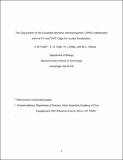| dc.contributor.author | Fuller, Adelaide M. | |
| dc.contributor.author | Cook, Elizabeth G. | |
| dc.contributor.author | Kelley, Kerry | |
| dc.date.accessioned | 2013-01-02T18:38:22Z | |
| dc.date.available | 2013-01-02T18:38:22Z | |
| dc.date.issued | 2010-03 | |
| dc.date.submitted | 2009-12 | |
| dc.identifier.issn | 0016-6731 | |
| dc.identifier.uri | http://hdl.handle.net/1721.1/75821 | |
| dc.description.abstract | TAHRE, the least abundant of the three retrotransposons forming telomeres in Drosophila melanogaster, has high sequence similarity to the gag gene and untranslated regions of HeT-A, the most abundant telomere-specific retrotransposon. Despite TAHRE's apparent evolutionary relationship to HeT-A, we find TAHRE Gag cannot locate to telomere-associated “Het dots” unless collaborating with HeT-A Gag. TAHRE Gag is carried into nuclei by HeT-A or TART Gag, but both TART and TAHRE Gags need HeT-A Gag to localize to Het dots. When coexpressed with the appropriate fragment of HeT-A and/or TART Gags, TAHRE Gag multimerizes with either protein. HeT-A and TART Gags form homo- and heteromultimers using a region containing major homology region (MHR) and zinc knuckle (CCHC) motifs, separated by a pre_C2HC motif (motifs common to other retroelements). This region's sequence is strongly conserved among the three telomeric Gags, with precise spacing of conserved residues. Nontelomeric Gags neither interact with the telomeric Gags nor have this conserved spacing. TAHRE Gag is much less able to enter the nucleus by itself than HeT-A or TART Gags. The overall telomeric localization efficiency for each of the three telomeric Gag proteins correlates with the relative abundance of that element in telomere arrays, suggesting an explanation for the relative rarity of TAHRE elements in telomere arrays and supporting the hypothesis that Gag targeting to telomeres is important for the telomere-specific transposition of these elements. | en_US |
| dc.description.sponsorship | Howard Hughes Medical Institute | en_US |
| dc.description.sponsorship | United States. National Institutes of Health (Grant GM50315) | en_US |
| dc.language.iso | en_US | |
| dc.publisher | Genetics Society of America, The | en_US |
| dc.relation.isversionof | http://dx.doi.org/10.1534/genetics.109.109744 | en_US |
| dc.rights | Creative Commons Attribution-Noncommercial-Share Alike 3.0 | en_US |
| dc.rights.uri | http://creativecommons.org/licenses/by-nc-sa/3.0/ | en_US |
| dc.source | Pardue via Courtney Crummett | en_US |
| dc.title | The Gag protein of the Drosphila telomeric retrotransposon TAHRE collaborates with HeT-A and TART Gags for nuclear localization | en_US |
| dc.title.alternative | Gag Proteins of Drosophila Telomeric Retrotransposons: Collaborative Targeting to Chromosome Ends | en_US |
| dc.type | Article | en_US |
| dc.identifier.citation | Fuller, A. M. et al. “Gag Proteins of Drosophila Telomeric Retrotransposons: Collaborative Targeting to Chromosome Ends.” Genetics 184.3 (2009): 629–636. © 2009 by the Genetics Society of America | en_US |
| dc.contributor.department | Massachusetts Institute of Technology. Department of Biology | en_US |
| dc.contributor.approver | Pardue, Mary-Lou | |
| dc.contributor.mitauthor | Fuller, Adelaide M. | |
| dc.contributor.mitauthor | Cook, Elizabeth G. | |
| dc.contributor.mitauthor | Kelley, Kerry | |
| dc.contributor.mitauthor | Pardue, Mary-Lou | |
| dc.relation.journal | Genetics | en_US |
| dc.eprint.version | Author's final manuscript | en_US |
| dc.type.uri | http://purl.org/eprint/type/JournalArticle | en_US |
| eprint.status | http://purl.org/eprint/status/PeerReviewed | en_US |
| dspace.orderedauthors | Fuller, A. M.; Cook, E. G.; Kelley, K. J.; Pardue, M.-L. | en |
| dc.identifier.orcid | https://orcid.org/0000-0002-4448-0785 | |
| dspace.mitauthor.error | true | |
| mit.license | OPEN_ACCESS_POLICY | en_US |
| mit.metadata.status | Complete | |
